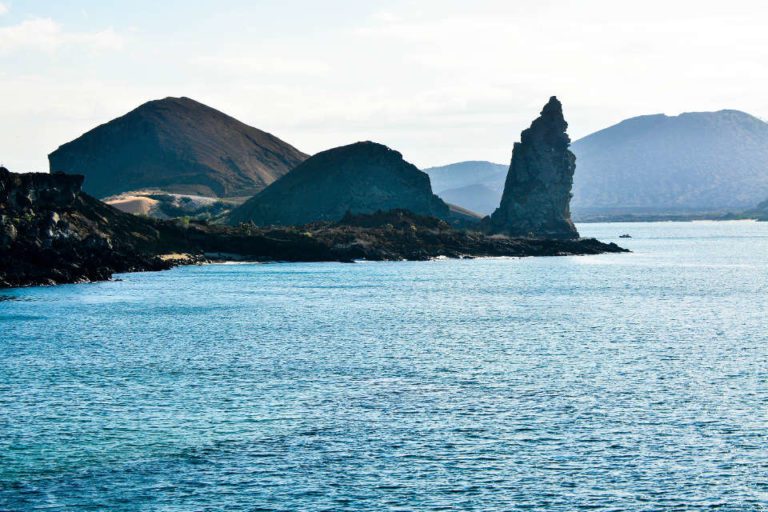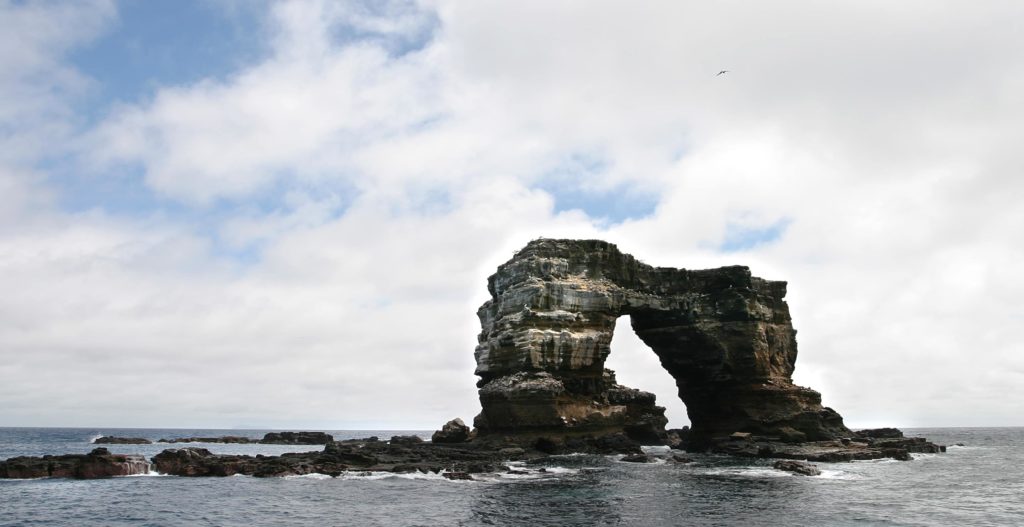The Galapagos Archipelago formed as a result of the submarine Galapagos hotspot, which has spouted molten lava out of the earth’s surface for several millennia. As the lava exploded, poured over the islands, cooled and mixed with seawater, it has formed some spectacular geologic rock formations. Below, we have included a list of some of the most famous volcanic formations in the Galapagos for you to consider during your vacation. But before starting to read, have you heard about Sierra Negra, the Galapagos’ most famous volcano?
TALK TO A DESTINATION EXPERT

Diego Zapata

Rosa Mena

Sandy Lara

Diego Zapata

Rosa Mena

Sandy Lara
Kicker Rock
One of the most important volcanic formations in the Galapagos is the Kicker Rock, located north of San Cristobal Island. This formation rises out from the ocean surface like an enormous shark fin in the middle of the ocean; however, it is most often compared to a boot (hence its name in English) or a sleeping lion, which is why it was termed Leon Dormido in Spanish. The site is known as a popular snorkeling site, thanks to a large number of Galapagos sharks, rays, sea lions, turtles, and other wildlife it attracts, as well as the hundreds of frigatebirds and blue-footed boobies that use the rock as a nesting ground. Furthermore, the 140-meter tall volcanic rock tower is split into two, and swimmers are able to venture in between the channel that extends 19 meters below the ocean surface.
Las Grietas
Of the many diverse volcanic formations in the Galapagos, Las Grietas, on Santa Cruz is certainly one of the most famous. This secluded lagoon is filled with brackish water and formed as two enormous cliffs moved apart. There are very few fish that inhabit this pool, but the most spectacular thing about this crevice is the color of the water – so clear that you can see both ends and even the plants that grow at the bottom. Pure fresh water is filtered into the pool from the above rock; however, the bottom consists of saltwater that has found its way here from the ocean, resulting in an interesting mixture of brackish water.
Contact an expert and design your Galapagos itinerary to visit these wonderful volcanic formations!
Pinnacle Rock

This is possibly the most famous landmark in the Galapagos Islands and certainly the most photographed image in the archipelago (even appearing in the movie “Master in Commander”). The rock is actually a tuff cone that formed from the explosion of an underwater volcano. After years of wind and water erosion, the resulting rock took on the cone shape it is now so renowned for. Pinnacle rock is located on Bartolome Island, and the nearby beach is a popular snorkeling site among tourists due to the beautiful marine life that inhabits the area, including the Galapagos penguin. After swimming in these beautiful waters, we suggest hiking up Bartolome to see the effect of the rock from afar. The formation is also breathtaking at sunset, but can only be enjoyed from a cruise ship.
Ocean Uplift
Ocean uplifts are one of the more unusual effects of volcanic formations in the Galapagos. Uplifts occur quite frequently, but in 1954 a particularly large uplift took place in which almost 4 miles of the seabed was lifted 15 ft. upwards at Urbina Bay on Isabela Island, extending the coastline an additional ¾ mile into the ocean. Thus, the initial section of the path was once located on the ocean floor, and the area still holds proof of its underwater beginnings. Tourists can find seashells, urchins, and delicately rounded rocks decorating the ground. Uplifts form when magma flows through a subsurface geological fault and exists in the form of lava, gradually lifting the landmass upwards.
Darwin’s Arch

This arch is a naturally formed rock arch located just offshore Darwin Island. However, the main draw of this landmark is the diving it offers. If you’re looking to see large animals during your dive, the waters around this arch offer some of the best in the world. Numerous hammerhead sharks, tiger sharks, whale sharks, and Galapagos sharks, as well as eagle rays, moray eels, and sea turtles, swim right alongside divers. Above the arch, a variety of endemic birds like to rest on the rock, and the island itself is home to the endemic Scooty Tern, which is found nowhere else in the Galapagos.

Javier Garcia

Eduardo Silva

Carolina Escobar
START PLANNING YOUR TRIP

Javier Garcia

Eduardo Silva

Carolina Escobar
Get in touch for more
CONTACT US
Image Credits: Wikipedia, Metropolitan Touring, Franscisco Dousdebes


